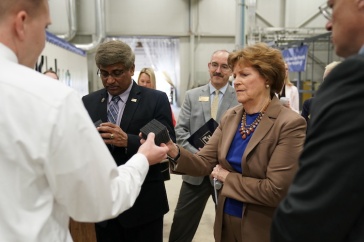
The Sarah Long Bridge, build in 1940, is being replaced with a new concrete lift bridge.
To locals, it’s known as “the middle bridge.” When it is finally complete, the replacement for the Sarah Mildred Long Bridge that spans the Piscataqua River between Portsmouth, New Hampshire, and Kittery, Maine, likely will be referred to often as the only concrete lift bridge in the country.
“It’s the first one of its kind in the U.S. The only other bridge like it is in France,” says Erin Bell, associate professor of civil and environmental engineering. What makes it unique? The new Sarah Long Bridge will have four 200-foot concrete lift towers instead of steel.
“Part of the reason for using concrete is architectural, and part of it is there’s not as much corrosion as with steel,” says Bell, who heads the Living Bridge Project which is gathering data on the Memorial Bridge that reopened in November 2013 after its own reconstruction. Both bridges had been on New Hampshire’s “red” list of deteriorating bridges for nearly a decade.

“There were people who thought the Memorial Bridge took a long time, but it was actually a modern marvel that a bridge that size would go in so quickly,” Bell says. “Some of the pieces were barged in and dropped into place. That saved some time.”
With the Sarah Long Bridge, it won’t be as simple as lowering sections into place because the navigational path of the bridge, now at an angle, has to be changed. The openings between the piers of the existing bridge aren’t in alignment; straightening that path, in addition to other design features, will allow larger ships to access the port and the river.
The Sarah Long is a double-truss bridge, with a deck for vehicle traffic on top and, below, a deck for rail service to the Portsmouth Naval Shipyard. There are two moveable spans, one to accommodate the majority of marine traffic and a second that lifts the rail bed and moves it on top of the railroad tracks, providing passage for smaller boats without having to stop vehicle traffic above.
“It’s the first one of its kind in the U.S."
When engineers design bridges, they think about how they would go about repairing or replacing them in the future, Bell says. Demolition of the Sarah Long Bridge, built in 1940, is still being discussed. The bridge was scheduled to close to vehicle traffic in November, but a mechanical failure at the end of August moved the date up. The lift has been left in the raised position so that marine traffic is not interrupted.
“It would have cost upwards of $1 million to repair it,” Bell says of the mechanical problem. “There was no way to justify the money knowing it would be closed permanently in a couple of months.”
The Sarah Long Bridge has a demolition plan in place that includes input from environmental and civil engineers as well as mariners. Bell plans to take students to the site before its removal.
Demolishing the old bridge could involve taking it apart in large pieces, removing the lift first, Bell says, to make the rest of the work easier. Explosives are sometimes used to take down a bridge; she mentions the Long Island Bridge in Quincy, Massachusetts, which was, in part, demolished that way. Barges were positioned below to catch falling debris, but there were still concerns regarding lead paint and other materials contaminating the water, she says.
“Based on the estuary and busy nature of the Piscataqua, the Sarah Long Bridge most likely will be dismantled piece by piece, with the pieces being barged out of the bay,” Bell says. “It will probably take a couple of months to take it apart. The current will help determine how much time it takes; it’s pretty fast there.”
Work on the $170 million project began in January 2015. It is expected to reopen to vehicle traffic in September 2017.
-
Written By:
Jody Record ’95 | Communications and Public Affairs | jody.record@unh.edu
















































